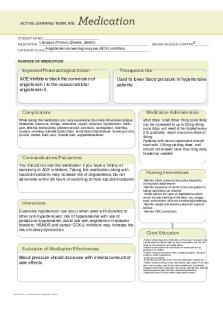Lisinopril - med sheet PDF

| Title | Lisinopril - med sheet |
|---|---|
| Author | Jessica Jewett |
| Course | fundamentals of nursing I |
| Institution | Lincoln Technical Institute |
| Pages | 1 |
| File Size | 56.4 KB |
| File Type | |
| Total Downloads | 24 |
| Total Views | 132 |
Summary
med sheet...
Description
ACTIVE LEARNING TEMPLATE:
Medication
STUDENT NAME _____________________________________
Lisinopril (Prinivil, Qbrelis, Zestril) 2 MEDICATION __________________________________________________________________________ REVIEW MODULE CHAPTER ___________ Angiotensin-converting enzyme (ACE) inhibitors CATEGORY CLASS ______________________________________________________________________ PURPOSE OF MEDICATION
Expected Pharmacological Action ACE inhibitors block the conversion of angiotensin I to the vasoconstrictor angiotensin II.
Therapeutic Use Used to lower blood pressure in hypertensive patients
Complications While taking this medication you may experience dizziness/drowsiness,fatigue, headache, insomnia, vertigo, weakness, cough, dyspnea, hypotension, chest pain, edema, tachycardia, abdominal pain, anorexia, constipation, diarrhea, nausea, vomiting, erectile dysfunction, renal dysfunction/failure, flushing of skin, pruritis, rashes, back pain, muscle pain, angioedema/fever
Medication Administration adult dose: initial dose 10mg once daily; can be increased to up to 20mg-40mg once daily; will need to be titrated every 2 to gradually reach maximum dose of 40mg Patients with renal impairment should start with 1.25mg starting dose, and should not exceed more than 5mg daily, titrated as needed
Contraindications/Precautions You should not use this medication if you have a history of sensitivity to ACE inhibitors; Taking this medication along with sacubitril/valsartin may increase risk of angioedema; Do not administer within 36 hours of switching to/from sacubitril/valsartin
Interactions Excessive hypotension can occur when used with diuretics or other anti-hypertensives; risk of hyperkalemia with use of potassium supplements; avoid use with angiotensin II receptor blockers; NSAIDS and certain COX-2 inhibitors may increase the risk of kidney dysfunction
Evaluation of Medication Effectiveness Blood pressure should decrease with minimal amount of side effects
ACTIVE LEARNING TEMPLATES
Nursing Interventions -Monitor blood pressure and pulse frequently during dose adjustments -Monitor frequency of refills to be sure patient is taking medication as directed -Asses patient for signs of angioedema which would include swelling of the face, lips, tongue, eyes, extremities; difficulty swallowing/breathing -Monitor weight and assess patient for signs of edema -Monitor CBC periodically
Client Education -Patient should take this medication at the same time each day; missed dose should be taken as soon as possible, but not too close to next dose(Do not double dose) -Patient should avoid salt substitutes or foods containing potassium or sodium -Patient should use caution when changing position, doing so slowly to avoid hypotension -Avoid use of alcohol -Avoid driving until you know how the medication affects you -Patient should notify primary care doctor right away if they notic rash; mouth sores; sore throat; fever; swelling of hands/feet; irregular heart beat; chest pain; dry cough; hoarseness; swelling face/lips/eyes/tongue; difficulty swallowing/breathing -Diabetics should monitor blood sugar levels closely...
Similar Free PDFs

Lisinopril - med sheet
- 1 Pages

Lisinopril - Med card
- 1 Pages

Medication Lisinopril
- 1 Pages

Omeprazole - med sheet
- 1 Pages

Allopurinol Med Sheet
- 1 Pages

Digoxin med sheet
- 1 Pages

Azithromycin Med Sheet
- 2 Pages

Albuterol - ati med sheet
- 1 Pages

Carbiopa levodopa med sheet
- 1 Pages

Enoxaparin med sheet
- 1 Pages

Phenytoin - med sheet
- 1 Pages

Ranitidine med sheet
- 1 Pages

Med injection cheat sheet-2
- 4 Pages
Popular Institutions
- Tinajero National High School - Annex
- Politeknik Caltex Riau
- Yokohama City University
- SGT University
- University of Al-Qadisiyah
- Divine Word College of Vigan
- Techniek College Rotterdam
- Universidade de Santiago
- Universiti Teknologi MARA Cawangan Johor Kampus Pasir Gudang
- Poltekkes Kemenkes Yogyakarta
- Baguio City National High School
- Colegio san marcos
- preparatoria uno
- Centro de Bachillerato Tecnológico Industrial y de Servicios No. 107
- Dalian Maritime University
- Quang Trung Secondary School
- Colegio Tecnológico en Informática
- Corporación Regional de Educación Superior
- Grupo CEDVA
- Dar Al Uloom University
- Centro de Estudios Preuniversitarios de la Universidad Nacional de Ingeniería
- 上智大学
- Aakash International School, Nuna Majara
- San Felipe Neri Catholic School
- Kang Chiao International School - New Taipei City
- Misamis Occidental National High School
- Institución Educativa Escuela Normal Juan Ladrilleros
- Kolehiyo ng Pantukan
- Batanes State College
- Instituto Continental
- Sekolah Menengah Kejuruan Kesehatan Kaltara (Tarakan)
- Colegio de La Inmaculada Concepcion - Cebu


